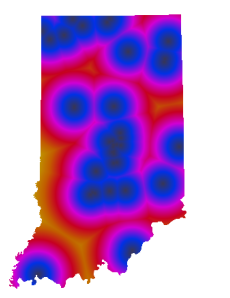Ranking the Indiana Breweries by Population
In my last post I used PostGIS to calculate the number of Hoosiers that live within 5 miles of an Indiana microbrewery. Now I want to rank each brewery by population. The total is going to be a little more than the 2.5 million-ish I came up in the last post due to the lucky duckies who live with 5 miles of more than one brewery.
Flat 12 of Indianapolis, with over 243,000 people within 5 miles of their location is our winner. No big surprise, but the top 11, and 12 of the top 13 are all Indy breweries.
A few breweries, most notably Three Floyds in Munster are lower than they should be because I only used Indiana census data. Three Floyds is only a half mile from the Indiana / Illinois border. If I included Illinois data the nearby Chicago population would have pushed them up the list.
The full list and the SQL used to create it are below the jump.

